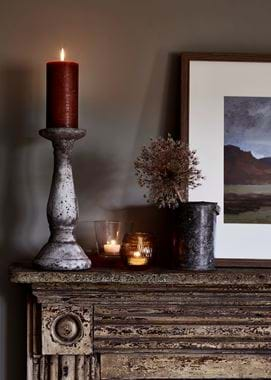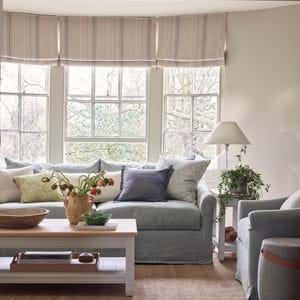Decorating with rust tones
Decorating with rust tones
Every season, we feature at least two seasonal shades. For autumn 2018, those are Chestnut and Walnut. Each one strong enough to be the focus in a room, but each with enough softness that they can sit back and act as an accent. We’ll be looking at deep and dark Walnut more and more as winter approaches, but autumn is a russet-toned season, so we start by exploring how you can use reddy, rust colours in your home.
Reasons to love rust
Rust is warm, cosy and comforting. Every time.
It’s usually seen as being a neutral – because neutral doesn’t have to mean pale, but rather tones that are easy to pair with any other colour and that will act as a good base to your scheme. More specifically, rust tends to be grouped with nature-inspired shades that the interior design world refer to as ‘earthy neutrals’, much like Sage was last year. Rust is therefore a surprisingly easy colour to use.
How to recognise rust
Rust is a term that covers those colours that blend brown, orange and red. Each time it might be a different tone that stands proud (orange with a base of brown, brown with a touch of red and orange behind it, and so on), but to be rust-worthy, there has to be brown somewhere in the base otherwise you venture into burgundy or burnt orange – colours that can help you to create a palette, but aren’t rust on their own.
It’s a family of hues. So you can either create a rust-like colour using tones of orange, red and brown (like what we’ve done on our new Sefton throw, Blyton candles and newest fabrics for example), or you can use different shades of orange, red and brown within your room to create an overall rust palette.
Rust as your dominant shade
In our autumn bedroom image, we’ve used our Chestnut paint on the main wall. The room could have taken Chestnut on every wall to make rust the pure focus. But, if you want more of a feature, choose the wall that your key piece of furniture is against as that’s where your eye will instinctively go. In a bedroom, that’s your bed – the wall that the headrest is against. In a living room, it’s what your sofa backs onto.
Now develop your scheme with a few contrasts as well as continuing your use of rust shades. White will cut through the softness of rust so use this if you want it to feel more contemporary and sharp. Sand and oatmeal colours on the other hand are where you should head towards if you want the whole room to be muted and wholesome. Or use a bit of white and a bit of oatmeal if you want to be between the two. You’ll need a few other bigger splashes of rust in the room to stop it from becoming diluted. Choose one or two pieces of upholstery, like a footstool or armchair, in one of our new rust textiles, then pick up on another fabric in the room, such as curtains, a throw or a rug and choose rust here too. If you’re in a dining room, consider having one of the core pieces of furniture painted in Chestnut instead.
Walls, upholstery, furniture all need to have been thought of with rust in mind if you want to make it your dominant colour, and then turn your attention to the little ‘pops’ of rust that reinforce your palette. More of that below.
Rust as an accent
Rust might be an earthy neutral, but there’s no escaping its stage presence. If you love its warmth but want more candle-flicker than roaring fireside in your room, use it as a secondary or tertiary colour.
Accents have different degrees of dominance too, of course. Picture using rust hues across all of your accessories and soft furnishings versus just on a few candles and maybe one lampshade.
Your first step is to decide how big on rust you want to go. Our Madeleine slipper chair upholstered in Harry Rust is a really lovely way to use rust as an accent. Use that alone and there’s your simple accent. Or, think about positioning it alongside a few scatter cushions on a bed or sofa – one of which could be pure rust, the other could be in our Samuel fabric which has just the occasional stripe in rust, and then add some of rust’s base colours, like the brown notes of Isla Grouse.
That’s another way to use rust as an accent – by using block colours of red, orange and brown throughout your room so that, when you step back, they combine to create a subtle nod to rust. Brown candles (like the Landscape scent from our Huxley collection, which is coming soon) on the mantelpiece, a tan leather footstool in the corner (try Milo in St James) or vintage radio on a side table or bookcase, a terracotta pot filled with seasonal cuttings on the window ledge, dark-stained floorboards or beams, a lamp table whose base is painted in Chestnut (try our circular Suffolk design) – little details like this, coloured appropriately, are your building blocks for giving rust a warm welcome into your home, without letting it get too carried away…
Discover our rust-coloured designs in our new autumn collection.









